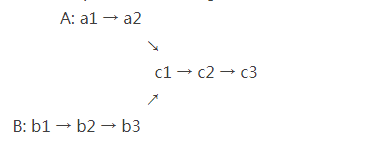
一、前言
本系列文章为《剑指Offer》刷题笔记。
刷题平台:牛客网
书籍下载:共享资源
二、题目
输入两个链表,找出它们的第一个公共结点。
1、思路
这道题和160.Intersection of Two Linked Lists是一样的。都是求两个链表的第一个公共结点。
公共结点的样子:
上图就是一个有公共结点的例子,在公共结点之后,两个链表指针指向的地址是相同的。
这道题有两个解法。
方法一:
我们可以把两个链表拼接起来,一个pHead1在前pHead2在后,一个pHead2在前pHead1在后。这样,生成了两个相同长度的链表,那么我们只要同时遍历这两个表,就一定能找到公共结点。时间复杂度O(m+n),空间复杂度O(m+n)。
方法二:
我们也可以先让把长的链表的头砍掉,让两个链表长度相同,这样,同时遍历也能找到公共结点。此时,时间复杂度O(m+n),空间复杂度为O(MAX(m,n))。
2、代码
C++:
这里使用方法二。
/*
struct ListNode {
int val;
struct ListNode *next;
ListNode(int x) :
val(x), next(NULL) {
}
};*/
class Solution {
public:
ListNode* FindFirstCommonNode( ListNode* pHead1, ListNode* pHead2) {
// 如果有一个链表为空,则返回结果为空
if(pHead1 == NULL || pHead2 == NULL){
return NULL;
}
// 获得两个链表的长度
unsigned int len1 = GetListLength(pHead1);
unsigned int len2 = GetListLength(pHead2);
// 默认 pHead1 长, pHead2短,如果不是,再更改
ListNode* pHeadLong = pHead1;
ListNode* pHeadShort = pHead2;
int LengthDif = len1 - len2;
// 如果 pHead1 比 pHead2 小
if(len1 < len2){
ListNode* pHeadLong = pHead2;
ListNode* pHeadShort = pHead1;
int LengthDif = len2 - len1;
}
// 将长链表的前面部分去掉,使两个链表等长
for(int i = 0; i < LengthDif; i++){
pHeadLong = pHeadLong->next;
}
while(pHeadLong != NULL && pHeadShort != NULL && pHeadLong != pHeadShort){
pHeadLong = pHeadLong->next;
pHeadShort = pHeadShort->next;
}
return pHeadLong;
}
private:
// 获得链表长度
unsigned int GetListLength(ListNode* pHead){
if(pHead == NULL){
return 0;
}
unsigned int length = 1;
while(pHead->next != NULL){
pHead = pHead->next;
length++;
}
return length;
}
};
Python:
这里使用方法一:
# -*- coding:utf-8 -*-
# class ListNode:
# def __init__(self, x):
# self.val = x
# self.next = None
class Solution:
def FindFirstCommonNode(self, pHead1, pHead2):
# write code here
if pHead1 == None or pHead2 == None:
return None
cur1, cur2 = pHead1, pHead2
while cur1 != cur2:
cur1 = cur1.next if cur1 != None else pHead2
cur2 = cur2.next if cur2 != None else pHead1
return cur1
来源:
https://cuijiahua.com/blog/2018/01/basis_36.html




